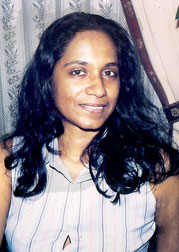|
Nirmala de Alwis:
The elephant’s majesty impacts her art
 The road leads to a compound of scenic beauty of tropical splendour
with tall shady trees spread like an umbrella. Entering the huge
mansion, I observed that it was fine in spaciousness, with a big
wall-hanging of an elephant done in papier mache (made up of paper
pulp). The road leads to a compound of scenic beauty of tropical splendour
with tall shady trees spread like an umbrella. Entering the huge
mansion, I observed that it was fine in spaciousness, with a big
wall-hanging of an elephant done in papier mache (made up of paper
pulp).
It reminded me of the great days when hospitality was offered to high
rankers of the administration and the affluent rich, who dined and wined
with their spouses till the wee hours. After some time a tall figure
approached and greeted me. She was none other than Nirmala de Alwis, a
wildlife artist, and the daughter of the late Lyn de Alwis, Director of
the Zoological Gardens and Wildlife. The De Alwis’ have left a colourful
history in Sri Lanka, Lyn de Alwis (a distinguished Thomian) and
internationally well-known wildlife and nature conservationist and his
younger brother Neville de Alwis warden of S. Thomas’ College, Mt.
Lavinia.
Nirmala de Alwis born in Colombo, grew up in an environment of
animals and plants in her home near the National Zoological Gardens.
From early childhood at Ladies’ College, Colombo, Nirmala developed a
passion to draw animals such as tigers, lions, leopard cubs, and
monkeys. As she reached maturity she turned out to be one of the best
wildlife artists in her generation.
She was fortunate to come under the tutelage of gate-Mudaliyar,
A.C.G.S. Amarasekera who taught the elements of art. Later, she studied
under S. Mittapala who taught her to paint animals and learn the art of
using colours to portray animals in their natural habitat. She completed
her A/Ls at Ladies’ College, Colombo.
|

Nirmala de Alwis |
|

One of her paintings |
Her striking beauty and slim figure however would have led to a
successful dancing career.
Nirmala had only to take a few steps moving to rhythm when the drums
begin to throb. But God had much more in store for her.
She proceeded to Singapore with her parents and entered the Nanyang
Academy of Fine Arts where she completed a course in art.
As an art student, she took part in the Singapore Festival of Arts in
1992 and the Asia Pacific Art Exhibition in the same year.
Returning to Sri Lanka with much experience in art, she worked in a
leading advertising agency in Colombo where she gathered experience in
production, radio commercials and handling various advertising campaigns
with reputed firms.
But her forte was elephants and a passion to depict nature in every
medium, oil, pastel, charcoal, watercolour, acrylic and pen and ink
drawings. Her frequent visits to the National Parks and sanctuary
sharpened her skills in drawing and painting every animal, especially,
the magnificent elephant and give her appreciation and respect for
animals. Nirmala always experiments with colour effects at the expense
of her favourite pets, the leopard, deer and elephant. In many instances
her experiments were successful, and the pigments have retained their
life-like freshness to the present day.
Interestingly, the older she grew the more skilful she became not
only in the mixture of colours, but also in the texture of the design.
Her art never suffered from the sunset of an outlived inspiration. On
the contrary, like good wine it improved with age.
Nirmala held her first solo exhibition in 1998 at the National Art
Gallery, the second at the Lionel Wendt, the third on an invitation by
Alliance Francaise, Colombo and the fourth solo exhibition ‘Hasthi’ at
Havelock Place Bungalow which was most successful.
Nirmala said, “Having grown up in a unique setting near the premises
of the zoo, and being foster mother to a menagerie of wild animals, I
had the impact to do animal portraits of most of the creatures I love!
At best I call myself a wildlife painter, elephants being my main
subject”.
“What I love most about them is that they invoke strong sentiments in
the viewer possibly because they are the largest land mammals and of
course their beauty and strength and imposing majesty.
“They have been the mainstay in Sri Lankan art impressions and they
still stay culturally entwined to everyday life”. |


